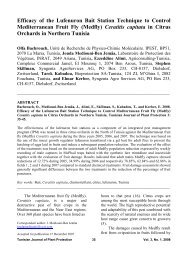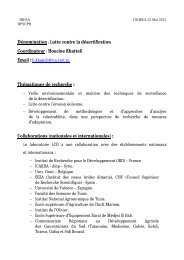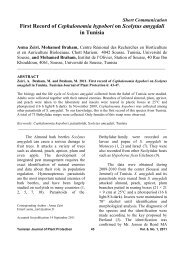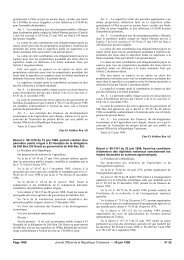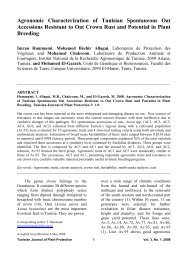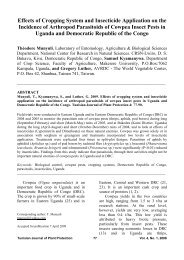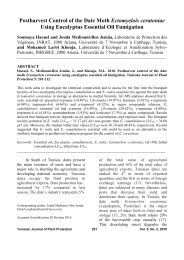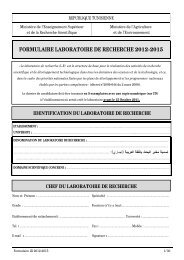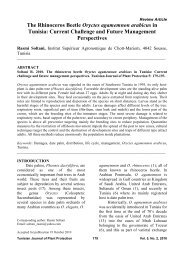Cyromazine Induced Effects on Larvae and Adults of ... - Iresa
Cyromazine Induced Effects on Larvae and Adults of ... - Iresa
Cyromazine Induced Effects on Larvae and Adults of ... - Iresa
You also want an ePaper? Increase the reach of your titles
YUMPU automatically turns print PDFs into web optimized ePapers that Google loves.
Emergence rate (%)<br />
100<br />
80<br />
60<br />
40<br />
20<br />
a<br />
a<br />
b<br />
b<br />
0<br />
0 0,05 0,1<br />
Dose (mg/l)<br />
0,2<br />
Fig. 4. Emergence rate <strong>of</strong> C. capitata adults exposed to different cyromazine doses<br />
DISCUSSION<br />
In Tunisia, C. capitata has been a<br />
serious pest <strong>of</strong> several fruit crops mainly<br />
citrus <strong>and</strong> is found all around the year. It<br />
may complete seven or eight generati<strong>on</strong>s<br />
per year, five <strong>of</strong> them are during the<br />
summer (16, 19).<br />
Results reported in this work clearly<br />
dem<strong>on</strong>strate that cyromazine ingested by<br />
larvae <strong>and</strong> adults <strong>of</strong> C. capitata induced a<br />
pois<strong>on</strong>ing syndrome that include<br />
significant mortality <strong>of</strong> all developmental<br />
stages, reducti<strong>on</strong> in female fertility,<br />
increase <strong>of</strong> percentage <strong>of</strong> body<br />
deformities <strong>and</strong> decrease <strong>of</strong> adult<br />
emergence rate.<br />
Many studies have been reported <strong>on</strong><br />
the insecticidal activity <strong>of</strong> cyromazine<br />
against C. capitata. Indeed, Viňuela et al.<br />
(36) reported that C. capitata larvae<br />
reared <strong>on</strong> an artificial diet supplemented<br />
with cyromazine undergo severe<br />
developmental disrupti<strong>on</strong> depending <strong>on</strong><br />
their age <strong>and</strong> exposure durati<strong>on</strong>.<br />
Moreover, Viňuela <strong>and</strong> Budia (35)<br />
indicated that Medfly larvae treated with<br />
cyromazine (20 mg/Kg <strong>of</strong> diet) were<br />
smaller, more el<strong>on</strong>gate <strong>and</strong> c<strong>on</strong>siderably<br />
Tunisian Journal <strong>of</strong> Plant Protecti<strong>on</strong> 214<br />
less elastic than c<strong>on</strong>trol. On the c<strong>on</strong>trary,<br />
when sub-lethal c<strong>on</strong>centrati<strong>on</strong>s were<br />
added to the larval rearing medium, no<br />
body alterati<strong>on</strong>s were recorded.<br />
Furthermore, at the c<strong>on</strong>centrati<strong>on</strong> <strong>of</strong> 20<br />
mg/Kg <strong>of</strong> diet, larvae <strong>of</strong> C. capitata<br />
develop severe symptoms, less than 20%<br />
<strong>of</strong> them are able to pupate <strong>and</strong> n<strong>on</strong>e<br />
emerge adults (36). In additi<strong>on</strong>,<br />
cyromazine is known to affect dipteran<br />
puparia with lethal outcome (8). These<br />
authors reported that cyromazine has an<br />
effect <strong>on</strong> pupae cuticle <strong>of</strong> Musca<br />
domestica. Besides, Kayser <strong>and</strong> Palivan<br />
(22) reported that, when larvae <strong>of</strong><br />
dipteran species (M. domestica, Lucilia<br />
sericata, Calliphora vicina <strong>and</strong><br />
Protophormia terraenovae) were feed<br />
with diet added with cyromazine (0.25<br />
mg/l), there is an important insecticidal<br />
effect. In another c<strong>on</strong>text, Reynolds <strong>and</strong><br />
Blakey (29) have shown that an early<br />
acti<strong>on</strong> <strong>of</strong> cyromazine is to cause the<br />
cuticle to become less extensible when<br />
subjected to simple c<strong>on</strong>stant load<br />
extensi<strong>on</strong> tests. Additi<strong>on</strong>ally, the effect <strong>of</strong><br />
cyromazine <strong>on</strong> cuticle mechanical<br />
properties occurred rapidly after exposure<br />
Vol. 5, No. 2, 2010






